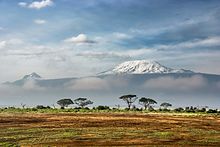

The Amboseli National Park is a National park in the southwest Kenya, right on the border too Tanzania. From Amboseli National Park, which is around 1,200 m above sea level, you have a direct view of the highest mountain in Africa, the Kibo in the Kilimanjaro massif (5,895 m). The mountain itself is in Tanzania, but determines the weather, especially the rainy days of the Kenyan National Park at its feet.
background

history
The national park was established in 1974. Its magnificent location at the foot of Kilimanjaro and its excellent opportunities to see Kenya's animals make it one of the most visited safari parks in Kenya.
landscape
The great, alkaline Amboseli Lake (Lake Amboseli), which gave the national park its name, covers around a third of the park area, but is only completely filled with water during the season. There is a canal-like connection between the swamps in the southern part of the park and Lake Amboseli. The landscape of this national park is characterized by gray dust containing soda. Acacia forests, swamps and open savannah alternate and provide a home for many large game species.
The owners of the surrounding land are Maasaiwho traditionally do not tolerate foreign hunters in their territory; The animal reserve has therefore largely been spared from poachers. For example, a population of african elephant whose age structure and generation structure have remained undistorted. Therefore, among the approximately 800 elephants there are also old cows and bulls, so that the rich and complex social behavior of the elephants can be observed. The only 390 square kilometer Amboseli Park, which is monitored by rangers and scientists all year round, is therefore home to the Amboseli Elephant Research Project, which has been investigating the social behavior, age structure and population dynamics of African elephants since 1972.
The Maasai water their ever-growing herds of cattle in Amboseli National Park, which affects the elephant population. A water pipeline to the north was not accepted, but technical deficiencies could not be permanently eliminated.
The elephants are very local and only leave the Amboseli basin at the edges. In the east there are contacts with conspecifics from the Tsavo West National Park, however, the groups keep separating. Occasionally, conspecifics come from the slopes of Kilimanjaro to Amboseli National Park.
Flora and fauna
Amboseli is known for its large herds of African elephants. There are over 900 African elephants in Amboseli as well as huge herds of wildebeest. There are also wildebeest, zebras, Grant and Thomson gazelles, impalas, giraffe gazelles, billy goats and some black rhinos. The predators include lions, cheetahs, hyenas, African wild dogs and two types of jackals. In the center of the Amboseli National Park there are palm thickets. Sour grasses, real papyrus, rushes, grow around the numerous swamps that are fed by Kilimanjaro and, in spite of the fact that the water resources change with the seasons and from year to year, are very abundant. salt contract end Bushes and yellow-bark acacias.
climate
- The climate in the Amboseli region is hot and dry. The national park lies in the rain shadow of Kilimanjaro, as it lies on the northwest side. Temperatures are 27 to 31 ° C during the day and 22 to 24 ° C at night all year round.
- Best travel time: January and February and from June to September. During the 2 rainy seasons (April-May and November-December) the rains can make the roads in Amboseli impassable. For bird watchers, the best months to see migratory birds are October through January.
getting there

Access is via the gates Namanga Gate in the northwest, Lembeiboti Gate in the north and Kimana Gate in the east. In addition, the national park has a runway for airplanes. From the Tsavo National Park it takes about 4-5 hours to get to Amboseli and the same time to get there Nairobi.
- 1 Kimana Gate
- 2 Meshanani Gate
- 3 Amboseli runway
Fees / permits
- Opening times: daily from 6:00 a.m. to 6:15 p.m.
- Entrance fee: USD 60, children 35
- Payment methods: MPESA, VISA Card, direct payments to KWS bank accounts at each gate. No cash payment possible
mobility

Tourist Attractions

The main purpose of a wildlife safari is to see the wild animals of Kenya in their natural habitat. Amboseli National Park is known for its large herd of over 900 wild elephants. This is the best national park for elephant watching. The best observation times are early and late in the day, as animals sleep in the hot midday sun.
activities
shop
kitchen
accommodation
In the park center there are some safari guesthouses with a high standard. The park also has a place to camp.
security
trips
literature
- Wally and Horst Hagen: The African national parks as habitats for elephants. In: Vitus B. Dröscher (1990): Save the elephants of Africa (Pp. 223–225)
Individual evidence
Web links
- Kenya Wildlife Service - Amboseli National Park (English)
- Amboseli (English)
